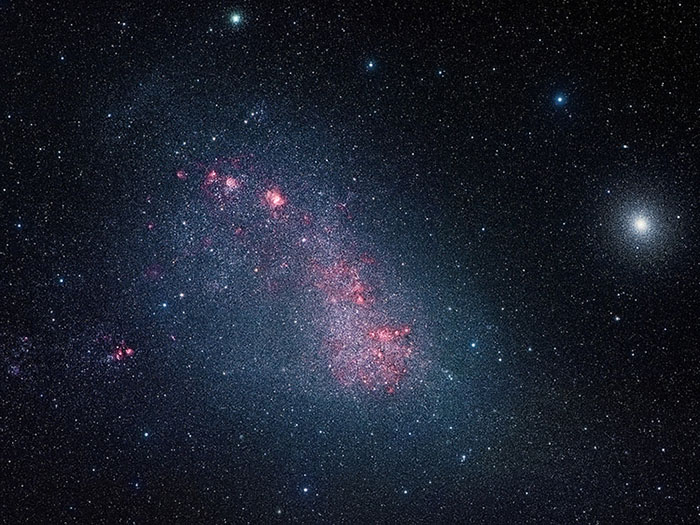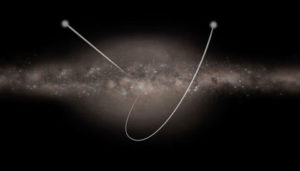The discovery of a runaway star in the Small Magellanic Cloud suggests that runaway stars are a common phenomenon in the universe.
Astronomers recently spotted a rare kind of runaway star speeding through the Milky Way’s neighboring galaxy, the Small Magellanic Cloud. While only a few dozen runaway stars are known, this particular find suggests that these objects might be common in the universe.
Massey and lead author Kathryn Neugent (University of Washington and Lowell Observatory) first found the star nine years ago while doing a survey of yellow supergiants in the Large and Small Magellanic Clouds, satellite galaxies of the Milky Way. The new study presents additional observations, which confirm that this star is really moving so quickly through its galaxy and isn’t just orbiting another star at high speed.

Alan Tough / S&T Online Photo Gallery
What makes the new sighting unique is not only the star’s high speed – 300 km/s (700,000 mph) – but also its advanced phase of evolution. The star, called J01020100-7122208, is a yellow supergiant like Polaris. Yellow supergiants are rare because this phase lasts only 10,000 to 100,000 years before the star balloons into a red supergiant, like Betelgeuse.
"It's unexpected to find a very rare object in a very rare phase. The joint probability is unlikely, so the implication is that runaways are quite common," says Warren Brown (Harvard-Smithsonian Center for Astrophysics), an expert on runaway stars who was not involved in the current study.
A runaway star is any star moving significantly faster than other stars within its birthplace; typically stars must move faster than 20 to 30 km/s (50,000 to 70,000 mph) to escape the galaxy's collective gravitational pull. But the stars' high speed doesn't affect their evolution, and it’s possible that such stars could even host planets.
Most known runaway stars are in the Milky Way, where stars are easier to see from Earth; J01020100-7122208 is only the second known evolved runaway in another galaxy.
How a star becomes a runaway is still unclear, but the leading theory suggests it can happen in a couple of ways. The first requires that the star be part of a binary system. When one of the pair explodes in a supernova, the whole system loses mass, enabling the other star to fly away at high speed. Or, if the binary system comes too close to the supermassive black hole at the center of our galaxy, one of the pair might be slingshotted away. Another theory suggests that as a star passes by other stars in a cluster, powerful gravitational interactions could propel it in a different direction.The high speed of J01020100-7122208 suggests it was probably ejected by an explosion, says study co-author Philip Massey (Lowell Observatory).
On a broader scale, watching the yellow supergiant evolve in another galaxy will help astronomers test evolutionary models generally for large stars, Massey adds. "This stage acts as a magnifying lens to let us see the flaws of earlier parts of stellar calculations."
Hunting Runaways

ESA / CC BY-SA 3.0 IGO
Runaway stars remain an enigma because they are hard to spot, and also because it’s difficult to pin down their origin in time and space. When a star is in motion, all astronomers can say is that if (for example) a star is 10 million years old, it would have started its journey no earlier than 10 million years ago. The exact time and place of its runaway departure is unknown.
"What you don't know as an observer, and would like to know, is the distribution of stars in space and their velocity," Brown says. The challenge is that it's tough to spot a runaway based purely on its speed. In the Milky Way – where stars are closer and easier to spot than in other galaxies – stars orbiting near the center of the galaxy will naturally move faster than those that are further out, he adds.
So what catches astronomers' attention are stars that are "running away" extremely fast. Brown said it's possible there are much slower runaways, but they aren't being spotted due to their lower speeds. The best hope for astronomers is to look for changes in the positions of millions of stars at a time; fortunately, Brown adds, the European Space Agency's Gaia mission is performing this work now.
 2
2









Comments
Peter Wilson
April 6, 2018 at 12:57 pm
Runaway stars often come from a family with an abusive parent...
You must be logged in to post a comment.
Anthony Barreiro
April 6, 2018 at 4:25 pm
I can understand that seeing one yellow supergiant that is also a runaway star is a very unexpected event. Kinda like winning the lottery and getting struck by lightning on the same day. But, at least to this layperson, it seems a bit of a stretch to conclude that runaway stars must be common. It's hard to draw any statistical inferences from a sample of one. Let's wait and see what Gaia finds.
You must be logged in to post a comment.
You must be logged in to post a comment.